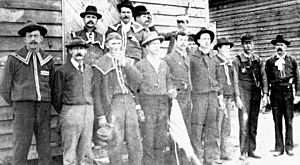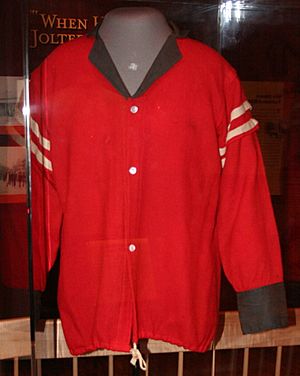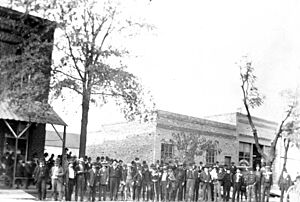Red Shirts (United States) facts for kids
Quick facts for kids Red Shirts |
|
|---|---|
| Participant in Reconstruction era | |

Red Shirts at a polling place in Old Hundred, North Carolina, on Election Day, November 8, 1898
|
|
| Active | 1875–1900s |
| Ideology | |
| Motives | White supremacy |
| Allegiance | Democratic Party (Redeemers) |
| Leaders |
|
| Area of operations | Southern U.S. (especially The Carolinas) |
| Allies | Redeemers, Ku Klux Klan, White League |
| Opponents | Republican Party, African Americans |
| Battles and wars | |
The Red Shirts were groups of white men in the Southern United States who were active in the late 1800s. They formed during and after the Reconstruction era of the United States, which was a time after the American Civil War when the Southern states were being rebuilt.
These groups wanted to bring back white control in politics and society. They were against the changes happening during Reconstruction, especially the new rights given to freedmen (formerly enslaved African Americans). The Red Shirts first appeared in Mississippi in 1875. They wore red shirts to be easily seen and to look more threatening to people who supported the Republican Party, including both white and Black citizens. Similar groups also started in North Carolina and South Carolina.
The Red Shirts were like a "military arm" for the Democratic Party in the South. They used organized actions, threats, and force to achieve their goals. They wanted to put Democrats back in power, remove Republicans, and limit the voting rights of African Americans. They played a big role in elections in the Carolinas, especially in 1876, 1898, and 1900, by trying to scare people away from voting for non-Democratic candidates.
Contents
Why They Wore Red Shirts
The idea of wearing red shirts started in Mississippi in 1875. According to historian E. Merton Coulter, these "southern brigadiers" of the Democratic Party wore red to show their opposition to Black Republicans. They would interrupt Republican meetings, threaten Black leaders, and try to stop Black people from voting.
In Charleston, South Carolina, men wearing red shirts marched in a Democratic parade on August 25, 1876. This was partly to make fun of a speech by Benjamin Franklin Butler. He was wrongly said to have shown a shirt stained with blood to gain support for Republican policies. The phrase "waving the bloody shirt" became a way to describe using emotional stories to get political support.
The red shirt symbol quickly became popular. People accused in the Hamburg massacre wore red shirts when they went to court in Aiken, South Carolina. Martin Witherspoon Gary, who organized the Democratic campaign in South Carolina in 1876, told his supporters to wear red shirts at all party events.
Wearing a red shirt became a symbol of pride and resistance for white Democrats in South Carolina. Women even sewed red shirts and wore red ribbons. Young men who were too young to have fought in the Civil War wore red shirts to show their strong support for the cause.
Red Shirts in South Carolina
Democrats in South Carolina organized parades and rallies in every county. Many participants were armed and rode horses, which made them look even more powerful. When Democratic leaders like Wade Hampton III spoke, the Red Shirts would cheer loudly, shouting "Hurrah for Hampton!" This created a big, exciting event that brought their supporters together.
The Red Shirts aimed to scare both white and Black voters into voting for Democrats, or not voting at all. Their main goal was to bring back Democratic rule and white control. These groups were especially active in states where African Americans were the majority. They broke up Republican meetings and tried to stop Black voters at the polls. Many African Americans became too scared to vote, and some felt pressured to vote for Democrats. The Red Shirts and similar groups did use violence. In some areas, Black people who voted were forced from their homes and whipped, and some of their leaders were even killed.
During the 1876 presidential election, Democrats in some counties voted many times, while Black people were stopped from voting. Armed Red Shirts rode with Wade Hampton as he traveled the state. They would attend Republican meetings, sometimes just standing silently to intimidate. Other times, they would hold a barbecue nearby to try and convince Republicans to vote Democratic.
Hampton tried to present himself as a calm leader, promising to support education and offer protection from violence. However, most African Americans remained loyal to the Republican Party. The 1876 campaign was very intense in South Carolina.
After the election on November 7, there was a long argument over who won. About 5,000 Red Shirts gathered at the South Carolina State House to support the Democrats. Hampton asked them to be calm, and they left.
In April 1877, President Rutherford B. Hayes ordered the Union Army to leave South Carolina. This allowed white Democrats to fully take control of the state's government. In the 1878 election, the Red Shirts made a small appearance as Hampton was re-elected without any opposition.
Later, South Carolina politicians like Benjamin Tillman and Ellison D. Smith proudly mentioned their past involvement with the Red Shirts.
Red Shirts in North Carolina

The Red Shirts became active again around the 1896 and 1898 elections in North Carolina. They worked with Democrats who wanted to promote white control. This was to stop voters from supporting the "Fusionists," a group made up of Republicans and Populists, who had gained power in the state government.
These Fusionist groups, which included both white and Black people, had become strong in North Carolina and other Southern states. Many white people were afraid of Black people gaining more power. To break up this group, white Democrats used threats and violence to reduce Black Republican voting. This helped them regain control of the state government in 1896.
Before the 1898 election, threats and violence against Black people increased, especially in counties where Black people were the majority. On November 4, 1898, a newspaper reported that the first Red Shirt parade on horseback in Wilmington, North Carolina, made white people excited and Black people worried.
Wilmington was the largest city in North Carolina at the time, and most of its population was Black. In 1898, a mixed-race group of Republicans won the city's mayor and council positions. However, white Democrats in the city wanted power. Six days after the election, they took control in what is known as the Wilmington Insurrection of 1898. This event is considered the only successful overthrow of a government in United States history. After taking over, the mob attacked Black areas of the city, killing many Black people and burning homes, schools, and churches. So many Black people left Wilmington that the city's population became mostly white.
White Democrats in the state government then created a change to the state constitution. This change made it very hard for most African Americans and many poor white people to vote. They added requirements like poll taxes (a fee to vote) and literacy tests (tests to prove you could read and write). This amendment was approved in 1900, with Black voter turnout being suppressed.
From 1896 to 1904, Black voter turnout in North Carolina dropped to almost zero because of these new voting rules. This was similar to what happened in other Southern states.
How the Group Grew
Many white Democrats in North Carolina felt they had lost political power. So, the Democratic Party and the Red Shirts aimed to get full control back. The Red Shirts used threats and attacks to scare Black voters, almost completely stopping them from voting in the state. Red Shirts were first seen in North Carolina at a rally in Fayetteville, North Carolina, on October 21, 1898. At this rally, Benjamin Tillman, a leader of the South Carolina Red Shirts, gave a speech. After his speech, many Red Shirt activities began in North Carolina.
The North Carolina Red Shirts included people from all social classes, like teachers, farmers, merchants, and some wealthy members of the Democratic Party. From that day on, Red Shirt groups were very active in southeastern North Carolina, especially in counties near the South Carolina border that had large Black populations.
Their early actions were part of the white control movements of 1898 and 1900. These movements started because more Black government officials were being elected in North Carolina between 1894 and 1897. This increase made the Democratic Party feel "frightened and desperate," leading them to start the white control campaign, with the Red Shirts as key partners. Unlike the Ku Klux Klan, the Red Shirts worked only with the Democratic Party. They operated openly because they wanted everyone in North Carolina to know who their members were. By the end of the 1898 election, they had become a very strong political force.
The 1898 Election
During the early period of Red Shirt activity, Senator Jeter Pritchard (Republican) of North Carolina wrote to President McKinley asking for help to keep the peace. The Red Shirts used threats and sometimes violence to stop non-Democrats from voting. As the Red Shirts' threats increased, both Black people and threatened white people started buying weapons to protect themselves. Senator Pritchard noted that the Red Shirts were most active "in counties where colored people predominate," and they targeted Black people.
Governor Daniel L. Russell (Republican) said that in the southern part of the state, "armed and lawless" men had taken over due to increased crime and violence. The Red Shirts often broke up non-Democratic political meetings with "threats, intimidation, and actual violence." Through their actions, the Red Shirts successfully scared many people away from registering to vote in the 1898 state election. Because citizens were afraid to register, Governor Russell issued a statement on October 26, 1898, asking all "ill-disposed persons... to immediately stop all unlawful practices... and to preserve peace." Governor Russell's statement did not stop the Red Shirts; they actually increased their activities.
Before the 1898 Election
The week before the 1898 election, the Red Shirts were constantly active. Their threats were so frequent that many Republican and Fusionist speakers canceled their events. The entire Republican Fusion ticket even withdrew in New Hanover County. A few days before the election, on November 2, 1898, a Wilmington newspaper reported a large rally. It involved 1,000 men in red shirts who marched for 10 miles in mostly Black areas of Richmond County, North Carolina. Their goal was "to show their determination to rid themselves of Negro rule." The paper also reported that "many Negroes [had] taken their names from the registration list."
1898 Election Day
On November 8, 1898, Election Day, Red Shirts were even more visible. They rode around voting places on their horses, carrying rifles and shotguns. This was meant to scare away all Republicans, Fusionists, and African Americans from the polls. The Red Shirts' actions helped the Democrats win with a large majority. A big celebration was organized on November 15 to celebrate "white supremacy and rescuing the state from Negro-rule."
The 1900 Election
Before the 1900 Election
The 1900 election was special because there was one in August and another in November. The theme of white control was repeated, with slogans like "White Rule for TarHeels" and "White Supremacy." The Red Shirts and Democrats wanted to ensure their win during the August special election, which was a plan to take away Black voting rights. The Democrats and Red Shirts believed that if they could "demoralize black leaders," the Black vote would decrease. On the day of the August election, a prominent Black leader, Abe Middleton, found a "pasteboard coffin" in his garden. He later said there was an increase in shooting near his home. While these incidents did not scare Middleton, other Black community members saw this activity and avoided voting. The Red Shirts' intimidation was so successful that many African Americans left their homes, some hiding in swamps.
The Red Shirts also continued to attack white Republicans and others who opposed the Democrats. The New York Times reported on August 2, 1900, that the day before the election, the Red Shirts interrupted a speech and destroyed the platform where the speaker stood. Many law enforcement officials did not act against the Red Shirts, indirectly supporting them. Later, a speaker named Mr. Teague was kidnapped by Red Shirts and driven out of town while traveling. Other non-Democratic speakers were disrupted by rotten eggs being thrown. Because of the Red Shirts' increasing disruptions, the Republican Party chairman of Johnson County asked Governor Russell for troops.
1900 Election Day
On the day of the 1900 election, the Red Shirts were even more obvious than in 1898. They rode around the voting polls with their guns and horses, scaring Black people and other Republicans. The success of taking away Black voting rights in the August 1900 election led to the Democratic governor, Charles Brantley Aycock, winning in November. His victory was noted as "the largest majority ever given to a gubernatorial candidate."
After the Democratic win in November, the Red Shirts were seen less often. Since many of their members were poor white people, the Democratic Party, which was made up of wealthier white people, began to distance itself from the group. So, the presence of Red Shirts decreased after Governor Aycock took office.
Modern Groups Using the Name
Today, some groups have used the name "Red Shirts." For example, a group in South Carolina has a special membership category called "Red Shirts." These groups have organized protests supporting the Confederate flag and against certain politicians.
In recent years, some other groups have also used the name "Red Shirts" for their marches. It is not clear if these modern groups know about the historical Red Shirts from the 1800s.
See also
 In Spanish: Camisas Rojas (Estados Unidos) para niños
In Spanish: Camisas Rojas (Estados Unidos) para niños
- 1876 South Carolina gubernatorial election
- History of South Carolina
- History of the Southern United States
- Reconstruction era of the United States
- List of Ku Klux Klan organizations. Reconstruction Era paramilitaries


